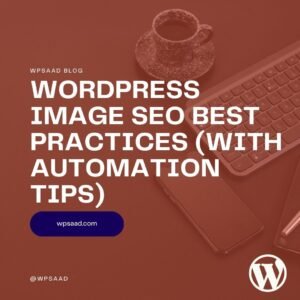Image SEO is one of the most underused ranking factors in WordPress. Most websites add high-quality visuals but ignore the metadata that helps search engines understand what those images represent. If you want to drive more traffic, improve accessibility, and enhance performance, it’s time to take image SEO best practices seriously.
In this article, we’ll show you how to optimize WordPress images for SEO using structured, scalable methods—plus automation tips to make the process faster and more efficient.
Why Image SEO Matters in WordPress
Search engines rely on more than just text. Images, if optimized correctly, can appear in Google Images, influence on-page SEO, and help content rank higher overall.
Here’s why image SEO is essential:
- Image metadata improves indexing
- Alt text enhances accessibility
- Title attributes add context
- Faster load times improve Core Web Vitals scores
If you’re skipping this step, you’re leaving traffic—and conversions—on the table.
Core Image SEO Best Practices
To properly optimize your images for search and accessibility, follow these steps:
✅ 1. Use Descriptive Filenames
Instead of uploading IMG_3849.jpg, rename it to something like wordpress-seo-checklist.png. Google uses filenames as a signal to understand the image’s subject.
✅ 2. Add Structured Alt Text
Alt text is not optional. It’s required for accessibility and plays a direct role in SEO. It should:
- Be specific and relevant to the page
- Describe the image clearly
- Include your focus keyword naturally
You can automate this with WordPress image alt automation (more on that below).
✅ 3. Optimize Image Title Attributes
The title attribute is the tooltip text that appears on hover. While it’s less important than alt text, it contributes to semantic richness and can improve the experience for users and search engines.
✅ 4. Compress Images Without Quality Loss
Large images slow down your site. Use tools like TinyPNG, ShortPixel, or built-in compression from your theme or CDN to maintain speed and performance.
✅ 5. Use Responsive Image Formats
Always use WordPress’s native srcset functionality. This ensures your images are served at the right size for the user’s screen—improving speed and UX.
✅ 6. Implement Lazy Loading
Lazy loading defers off-screen image loading until the user scrolls to them. WordPress supports this natively via the loading="lazy" attribute.
How to Optimize WordPress Images for SEO with Automation
Manually applying SEO rules to hundreds of images? That’s not scalable. Instead, use a reliable WordPress image alt automation plugin like Image Alt Text Manager by WPSaad.
It allows you to create dynamic alt and title templates using predefined tags like:
{{post_title}}{{site_title}}{{image_name}}{{image_caption}}{{image_description}}
You simply select which post types to apply the rules to (Posts, Pages, Media), and the plugin auto-updates all matching images in seconds.
Benefits of Automating Image Metadata
✅ Consistency – Alt and title attributes match your content
✅ Accessibility – Ensures compliance with WCAG 2.1
✅ SEO Accuracy – Aligns image metadata with on-page content
✅ Time Savings – Skip manual updates forever
✅ Future-Proofing – New content automatically inherits optimized templates
Using Image Alt Text Manager for Automation
Here’s how to set it up:
- Install the plugin from WordPress.org
- Go to Alt Manager → Settings
- Select your preferred post types (Posts, Pages, Media)
- Choose your alt/title tag template
- Save your settings — updates apply instantly
It works with featured images, inline content images, and the Media Library. The Pro version supports WooCommerce and Custom Post Types.
Pro Tips for Image SEO at Scale
- Use unique alt text for each post using dynamic tags
- Combine
{{post_title}}with{{site_title}}for branding - Regularly audit Media Library items for metadata coverage
- Don’t rely on AI-generated alt text—stay in control
- Avoid keyword stuffing in metadata—keep it relevant and readable
Conclusion: Image SEO Isn’t Optional Anymore
To compete in today’s SEO landscape, you need more than good content—you need optimized visuals. By following these image SEO best practices and using WordPress image alt automation, you improve performance, accessibility, and discoverability without increasing your workload.
Use automation to do the heavy lifting, and make image SEO part of your standard WordPress publishing workflow.
🔹 Try the Free Image Alt Text Manager Plugin
🔹 Upgrade to Pro for WooCommerce & CPT support

